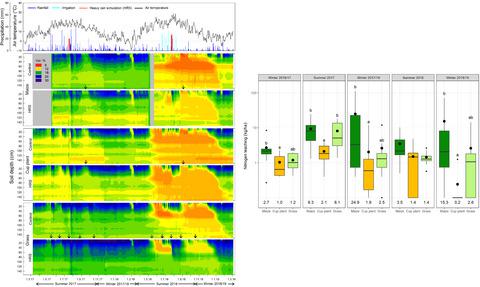当前位置:
X-MOL 学术
›
GCB Bioenergy
›
论文详情
Our official English website, www.x-mol.net, welcomes your
feedback! (Note: you will need to create a separate account there.)
Comparison of maize, permanent cup plant and a perennial grass mixture with regard to soil and water protection
Global Change Biology Bioenergy ( IF 5.9 ) Pub Date : 2020-07-14 , DOI: 10.1111/gcbb.12719 Dennis Grunwald 1 , Kerstin Panten 1 , Andreas Schwarz 2 , Wolf‐Anno Bischoff 2 , Siegfried Schittenhelm 1
Global Change Biology Bioenergy ( IF 5.9 ) Pub Date : 2020-07-14 , DOI: 10.1111/gcbb.12719 Dennis Grunwald 1 , Kerstin Panten 1 , Andreas Schwarz 2 , Wolf‐Anno Bischoff 2 , Siegfried Schittenhelm 1
Affiliation

|
Agricultural production of biogas maize (Zea mays L.) causes hazards to aquatic ecosystems through high levels of nitrogen (N) inputs. Newly introduced and already established perennial crops such as the cup plant (Silphium perfoliatum L.) and perennial grass mixtures offer the possibility of more environmentally friendly agricultural bioenergy production. The objectives of this field study were to quantify and compare soil mineral N, water infiltration, water runoff, soil erosion and N leaching under maize, permanent cup plant, and a perennial grass mixture. The study was conducted from October 2016 to March 2019 in Braunschweig, Germany. Plots with cup plant and grass mixture exhibited lower mineral N contents than maize, especially between 30 and 90 cm soil depth. Soil water infiltration was significantly different between the three crops. The grass mixture had the highest infiltration rates (6.2 mm/min averaged across 3 years), followed by cup plant (3.6 mm/min) and maize (0.9 mm/min). During wet periods, higher N leaching was found for maize (up to 42 kg N ha−1 year−1) than for cup plant (up to 5 kg N ha−1 year−1) or the grass mixture (up to 11 kg N ha−1 year−1). While runoff and erosion for cup plant and the grass mixture were negligible during the study period, considerable amounts of runoff water and eroded sediment of up to 1.5 Mg ha−1 year−1 were collected from the maize plots despite the near flat terrain of the experimental field. Overall, permanent cup plant proved suitable as a component for energy cropping systems to reduce the risk of N leaching and soil erosion, which is particularly important for the preventive flood protection in view of the more frequent occurrence of high intensity rainfall under climate change conditions.
中文翻译:

玉米,永久性杯植物和多年生草混合物在水土保持方面的比较
沼气玉米(Zea mays L.)的农业生产会通过大量输入氮(N)而对水生生态系统造成危害。新近引进和已经建立的多年生作物,例如杯形植物(Silphium perfoliatumL.)和多年生草混合物提供了更环保的农业生物能源生产的可能性。该田间研究的目的是量化和比较玉米,永久性杯植物和多年生草混合物下土壤矿质氮,水的渗透,径流,土壤侵蚀和氮的淋溶。该研究于2016年10月至2019年3月在德国不伦瑞克进行。装有杯具和草的混合物的地块的矿质氮含量比玉米低,尤其是在30至90厘米的土壤深度之间。三种作物之间的土壤水分渗透显着不同。草混合物的渗透率最高(3年内平均为6.2 mm / min),其次是杯形植物(3.6 mm / min)和玉米(0.9 mm / min)。在湿润时期,发现玉米的氮素淋失较高(最高至42 kg N ha-1 年-1)比盆栽植物(不超过5千克N ha - 1 年-1)或草料混合物(不超过11千克N ha - 1 年-1)。在研究期间,虽然杯具和草混合物的径流和侵蚀量可以忽略不计,但相当数量的径流水和侵蚀性沉积物可达1.5 Mg ha - 1 年-1尽管实验田地势平坦,但仍从玉米田中收集玉米。总体而言,永久性杯具被证明适合作为能源种植系统的组成部分,以减少氮淋失和水土流失的风险,鉴于在气候变化条件下高强度降雨的发生更为频繁,这对于预防洪水保护尤为重要。
更新日期:2020-07-14
中文翻译:

玉米,永久性杯植物和多年生草混合物在水土保持方面的比较
沼气玉米(Zea mays L.)的农业生产会通过大量输入氮(N)而对水生生态系统造成危害。新近引进和已经建立的多年生作物,例如杯形植物(Silphium perfoliatumL.)和多年生草混合物提供了更环保的农业生物能源生产的可能性。该田间研究的目的是量化和比较玉米,永久性杯植物和多年生草混合物下土壤矿质氮,水的渗透,径流,土壤侵蚀和氮的淋溶。该研究于2016年10月至2019年3月在德国不伦瑞克进行。装有杯具和草的混合物的地块的矿质氮含量比玉米低,尤其是在30至90厘米的土壤深度之间。三种作物之间的土壤水分渗透显着不同。草混合物的渗透率最高(3年内平均为6.2 mm / min),其次是杯形植物(3.6 mm / min)和玉米(0.9 mm / min)。在湿润时期,发现玉米的氮素淋失较高(最高至42 kg N ha-1 年-1)比盆栽植物(不超过5千克N ha - 1 年-1)或草料混合物(不超过11千克N ha - 1 年-1)。在研究期间,虽然杯具和草混合物的径流和侵蚀量可以忽略不计,但相当数量的径流水和侵蚀性沉积物可达1.5 Mg ha - 1 年-1尽管实验田地势平坦,但仍从玉米田中收集玉米。总体而言,永久性杯具被证明适合作为能源种植系统的组成部分,以减少氮淋失和水土流失的风险,鉴于在气候变化条件下高强度降雨的发生更为频繁,这对于预防洪水保护尤为重要。











































 京公网安备 11010802027423号
京公网安备 11010802027423号